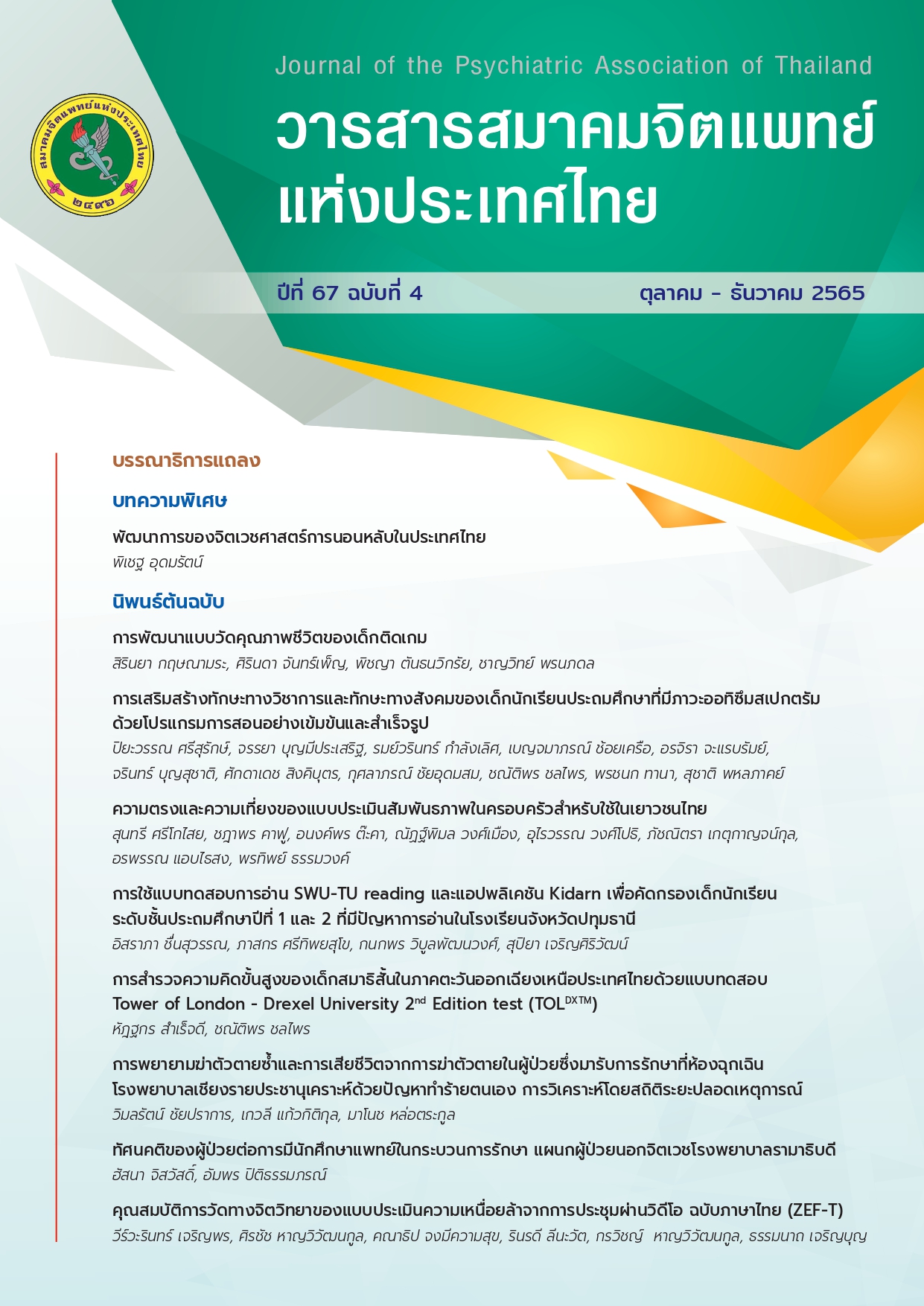Psychometric Properties of the Zoom Exhaustion & Fatigue Scale - Thai Version (ZEF-T)
Main Article Content
Abstract
Objectives: Overuse of video meetings during the COVID-19 pandemic may contribute to the new mental health problem called "Zoom fatigue". The aim of the study was to examine validity and reliability of the Thai version of the Zoom Exhaustion & Fatigue Scale (ZEF-T).
Methods: The ZEF-T was developed through forward and backward translation techniques and its content validity was evaluated by 5 psychiatrists. The final version was tested on 386 medical students from Thammasat University. Known-group validity was assessed by comparing the ZEF-T score among the group of medical students who attend video meetings with different frequencies. For convergent validity, the association between the ZEF-T score and Maslach Burnout Inventory - Student Survey (MBI-SS) and Patient Health Questionnaire (PHQ-9) were determined by Pearson’s correlation coefficient. The test-retest reliability of the ZEF-T was evaluated by using intraclass correlation coefficient. Internal consistency was calculated using Cronbach’s alpha coefficient.
Results: The results demonstrated that ZEF-T has excellent content validity with an average-content validity index of 0.97. The total ZEF-T score positively correlated with emotion exhaustion, cynicism, and depression score (r = 0.42, 0.38, 0.45, respectively, p<0.001 all), but negatively correlated with professional efficacy (r = -0.23, p<0.001). For known-group validity, participants with high video meetings (≥ 3 sessions/day) had significantly higher total ZEF-T scores than those with low meetings (0-2 sessions/day) [49.9(11.3) vs 41.1(12.2), p<0.001]. Internal consistency by the Cronbach’s alpha for the ZEF-T was 0.93, and test-retest reliability by intraclass correlation was 0.94 (p<0.001).
Conclusion: Zoom Exhaustion & Fatigue Scale – Thai version (ZEF-T) was proven to be a reliable and valid instrument for measuring zoom fatigue in university student contexts.
Article Details

This work is licensed under a Creative Commons Attribution-NonCommercial-NoDerivatives 4.0 International License.
Articles submitted for consideration must not have been previously published or accepted for publication in any other journal, and must not be under review by any other journal.
References
Riedl R. On the stress potential of videoconferencing: definition and root causes of Zoom fatigue. Electron Mark 2022;32(1):153-77.
Lowenthal P, Borup J, West R, Archambault L. Thinking beyond Zoom: Using asynchronous video to maintain connection and engagement during the COVID-19 pandemic. J Tech Teach Educ 2020;28(2):383-91.
Feijt M, de Kort Y, Bongers I, Bierbooms J, Westerink J, IJsselsteijn W. Mental health care goes online: Practitioners' experiences of providing mental health care during the COVID-19 pandemic. Cyberpsychol Behav Soc Netw 2020;23(12):860-4.
Bloom N, Davis SJ, Zhestkova Y. COVID-19 shifted patent applications toward technologies that support working from home. AEA Papers & Proc 2021;111:263-66.
Chawla A. Coronavirus (COVID-19) – ‘Zoom’ application boon or bane. SSRN 2020; DOI: 10.2139/ssrn.3606716.
Mamtani H, Karaliuniene R, de Filippis R, Nagendrappa S. Impact of videoconferencing applications on mental health. BJPsych International 2022;19(1):E1.
Lestari PW, Fayasari A. Zoom fatigue during the covid-19 pandemic: Is it real? Kesmas: National Public Health Journal 2022;17(2): 151-6.
Elbogen EB, Lanier M, Griffin SC, Blakey SM, Gluff JA, Wagner HR, et al. A national study of Zoom fatigue and mental health during the COVID-19 pandemic: Implications for future remote work. Cyberpsychol Behav Soc Netw 2022;25(7):409-15.
Peper E, Wilson V, Martin M, Rosegard E, Harvey R. Avoid Zoom fatigue, be present and learn. NeuroRegulation. 2021;8:47-56.
Bailenson JN. Nonverbal overload: A theoretical argument for the causes of Zoom fatigue. TMB 2021; 2(1):1-6.
Fauville G, Luo M, Queiroz ACM, Bailenson JN, Hancock J. Zoom Exhaustion & Fatigue Scale. Comput Hum Behav Rep 2021;4:100119.
Salim J, Arnindita JN, Tandy S. Validation of the Indonesian translated Zoom Exhaustion and Fatigue (ZEF-I) scale: A RASCH model and factor analysis. Fatigue: Biomed Health Behav 2022;10(2):107-18.
Yavuz G, Dogan N. Maslach Burnout Inventory-Student Survey (MBI-SS): A validity study. Procedia Soc Behav Sci 2014;116:2453-7.
Kroenke K, Spitzer RL, Williams JB. The PHQ-9: Validity of a brief depression severity measure. J Gen Intern Med 2001;16(9):606-13.
Lotrakul M, Sumrithe S, Saipanish R. Reliability and validity of the Thai version of the PHQ-9. BMC Psychiatry 2008;8:46.
Shi J, Mo X, Sun Z. Content validity index in scale development. J Cent South Univ (Med Sci) 2012;37(2):152-5.
Heale R, Twycross A. Validity and reliability in quantitative research. Evid Based Nurs 2015;18:66-7.
Koo TK, Li MY. A guideline of selecting and reporting intraclass correlation coefficients for reliability research. J Chiropr Med 2016;15(2):155-63.
Dol KS. Fatigue and pain related to internet usage among university students. J Phys Ther Sci 2016;28(4):1233-7.
Sanz-Blas S, Buzova D, Miquel-Romero MJ. From Instagram overuse to instastress and emotional fatigue: the mediation of addiction. Span J Mark - ESIC 2019;23(2):143-61.
Nesher SH, Wehrt W. Understanding “Zoom fatigue”: A mixed-method approach. Appl Psychol 2022;71(3):827-52.
Streiner DL. Starting at the beginning: An introduction to coefficient alpha and internal consistency. J Pers Assess 2003;80(1):99-103.
Queiroz CM, Nascimento A, Fauville G, Luo M, Meirelles F, Plank DN, et al. Translation, validation and application of the ZEF scale to assess Zoom fatigue in the Brazilian population [Internet]. 2021 [updated 2021 May 12; cited 2022 Oct 18]. Available at SSRN: https://ssrn.com/abstract=3844219 or http://dx.doi.org/10.2139/ssrn.3844219
Taikerd K, Ruaman K, Preecharlerdsin N, Nuallaong W, Rojpibulstit P. Prevalence and associated factors of burnout syndrome in preclinical medical students, Thammasat University. TMJ 2021;19:S127-S138.


